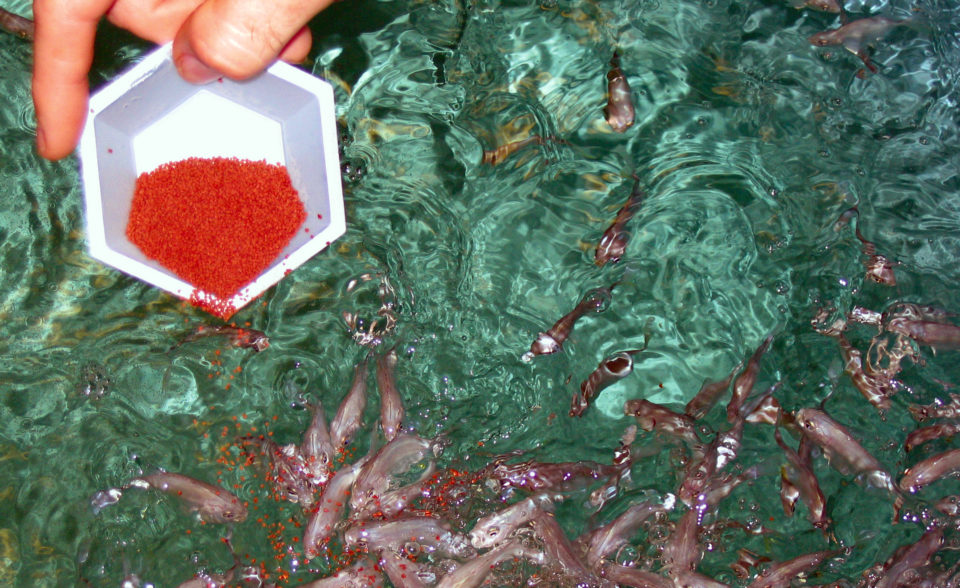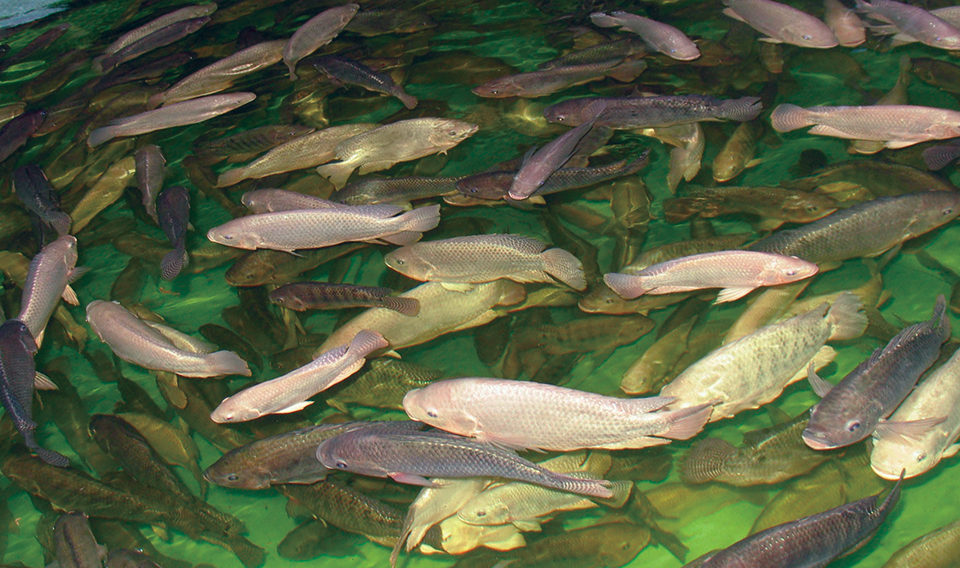Regulations vary by country and region

The U.S. Food and Drug Administration (FDA) process for registering an antibiotic in the United States is time-consuming, complex, and expensive. For this reason, very few antibiotics are approved for use in aquaculture. Those that are (Table 1) have very specific approved applications. A detailed description of the FDA position on antimicrobials in aquaculture is available online at http://www.fda.gov/cvm/JUAQUATIC.htm.
Newman, Antibiotics approved for specific applications in U.S. aquaculture, Table 1
| Brand Name | Comments |
|---|
Brand Name | Comments |
|---|---|
| Terramycin | Mono-alkyl trimethyl ammonium oxytetracycline |
| Romet | Ormetoprim:sulfadimethoxine combination, a potentiated sulfonamide |
| AquaFlor | Florfenicol |
| Sulfamerazine | Not available |
Not all countries apply the same standards regarding antibiotic use as the U.S. and European Union. As a result, many antibiotics that have not been rigorously tested are permitted to be used. As long as the tenets of appropriate use are followed, this does not automatically present a problem.
Appropriate use
Appropriate use is defined by a process that should be followed every time an antibiotic is prescribed, whether by a physician, veterinarian, or aquaculturist. Failure to follow the following steps could be considered antibiotic abuse in aquaculture.
- Determine whether a bacterial disease, not just a pathogen, is present. Antibiotics do not work against viruses, parasites, or fungi.
- Culture the pathogen(s) responsible for the disease and determine their antibiotic sensitivity patterns.
- Choose the appropriate approved antibiotic and use it in a manner consistent with eliminating the pathogen(s) and stopping the economic impact of the disease.
- Use the antibiotic at the correct dosage for the appropriate amount of time for a given environment. Temperature, for example, can affect efficacy and withdrawal times.
- Observe withdrawal times. Antibiotics must not be used at specified time intervals prior to harvest. Where no withdrawal times have been established using sound scientific methodologies, extreme conservatism is advised.
Resistance issues
Every use of an antibiotic puts selective pressure on the bacterial population. This is why it is important to use the proper antibiotic at an effective dosage for the proper amount of time and under the correct environmental conditions. Failure to do so can increase the likelihood of selection for resistant bacteria.
Bacteria readily exchange genetic material between species, with the end result that resistance can spread. When the abuse of antibiotics results in resistant human pathogens, the tragic results can be death and suffering from diseases that were once easily treatable.

Misconceptions
While there are valid concerns regarding antibiotics, there are also many misconceptions about antibiotic use. Explanations of those most relevant to aquaculture follow.
Any use of antibiotics in aquaculture is bad.
There is always a place for the responsible use of antibiotics in any agricultural practice. Proper use should result in reduction in the financial impact of the disease process and improved profitability without the associated down sides of improper use.
There are good and bad antibiotics.
Antibiotics are neither good nor bad. It is how they are used that is good or bad.
Several antibiotics have been banned for use in aquaculture, including chloramphenicol and the nitrofurans. Additional antibiotics will likely be banned, as well. The decision to ban these materials was based on the presence of residues in final products that consumers would purchase. Political, rather than strict scientific concerns are usually the basis for setting action levels.
As with any disparate group of chemicals, antibiotics can have a variety of undesirable side effects that range from minimal to death. Responsible use of antibiotics is required to ensure the absence of residues.
Antibiotic residues are inherently bad.
Antibiotics are molecules that animals ingest, metabolize, and excrete. Different drugs are metabolized in different ways and have different half-lives in different animals. Some antibiotics have allowable residues, while others have none. Many consumer-ready products are not screened for antibiotics and their metabolites.
Whether founded or not, concerns about the possible public health issues of a given antibiotic or its metabolites can encourage regulatory scrutiny that results in their outright ban or the implementation of allowable residue levels that are so low as to effectively constitute a ban.
All antibiotics are the same.
Antibiotics fall into two general categories: bactericidal antibiotics that kill bacteria and bacteriostatic antibiotics that prevent bacteria from growing, but do not kill them. Depending upon the dosages employed, some antibiotics fit both categories.
Usually, specific antibiotics work best against specific pathogens and subsequent diseases. There are a few exceptions to this, including rickettsial diseases such as Necrotising Hepatopancreatitis in shrimp, which universally respond to oxytetracycline.
Antibiotic use is the best way to deal with bacterial problems in fish and shrimp.
Many diseases in aquatic animals are stress-related. Bacterial pathogens invade weakened animals, and diseases may be self-limiting and recurrent.
While antibiotics can effectively stop acute mortality when animals are eating, they are not the best tools for dealing with the problem in the long run. Addressing the underlying cause of a disease is a better management tool. This usually entails such things as controlling pathogen loads and minimizing stress on animals by maintaining a clean and healthy environment. Disease is the result of a complex interaction between the pathogen, the host, and the environment – control measures should take this into account.
It is OK to promote growth and improved feed conversion with antibiotics.
While this may be legal in some sectors, many in the field consider this an unacceptable practice that constitutes abuse. It is not legal in the United States.
It is OK to prevent disease problems with antibiotics.
There are some cases where it makes sense to use an antibiotic to prevent a recurrent disease problem, but this is the exception rather than the rule. Responsible use precludes this approach to disease management in the vast majority of cases.
Responsible decisions
Antibiotics are sometimes abused in human medicine, agriculture, and aquaculture, too. The responsible use of antibiotics in aquaculture entails following protocols that ensure the compounds are effectively used for particular diseases in a manner that limits adverse impacts on the environment and public health.
Aquafarmers have choices, and consistently making the right ones would go a long way toward ensuring continued access to the critical antibiotics that are legitimately needed once in a while. Using these products in the absence of a diagnosis is simply not responsible. Decision makers need to implement appropriate strategies which consider that the long-term financial costs associated with failure to use antibiotics properly outweigh any short-term benefit derived from their usage.
(Editor’s Note: This article was originally published in the March/April 2007 print edition of the Global Aquaculture Advocate.)
Now that you've finished reading the article ...
… we hope you’ll consider supporting our mission to document the evolution of the global aquaculture industry and share our vast network of contributors’ expansive knowledge every week.
By becoming a Global Seafood Alliance member, you’re ensuring that all of the pre-competitive work we do through member benefits, resources and events can continue. Individual membership costs just $50 a year. GSA individual and corporate members receive complimentary access to a series of GOAL virtual events beginning in April. Join now.
Not a GSA member? Join us.
Author
-
Stephen G. Newman, Ph.D.
President, Chief Executive Officer
AquaInTech, Inc.
6722 162nd Place Southwest
Lynnwood, Washington 98037 USA
Tagged With
Related Posts

Health & Welfare
A holistic management approach to EMS
Early Mortality Syndrome has devastated farmed shrimp in Asia and Latin America. With better understanding of the pathogen and the development and improvement of novel strategies, shrimp farmers are now able to better manage the disease.

Health & Welfare
AHPN inferences based on behavior of vibrio bacteria
Vibrio parahaemolyticus, a strain of which is the cause of acute hepatopancreatic necrosis (AHPN), has both virulent and benign strains. This strain colonizes the stomachs of shrimp by the formation of a biofilm, which protects it from antibiotics and other potential treatments.

Health & Welfare
Antimicrobial resistance: complex, unavoidable
Resistance to antibiotics is unavoidable because it is an aspect of bacterial evolution. Resistant microflora have been observed in water that has not had recent contact with antimicrobial agents.

Health & Welfare
Do probiotics work in aquaculture?
Probiotics administered in feeds provide competitive exclusion of pathogenic bacteria, create conditions unfavorable for pathogens and modulate intestinal immune responses.


